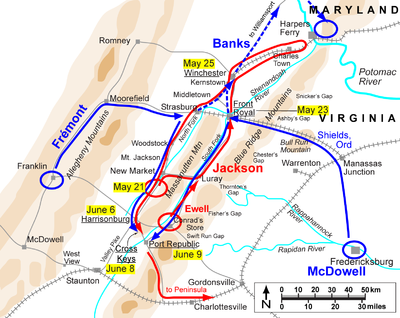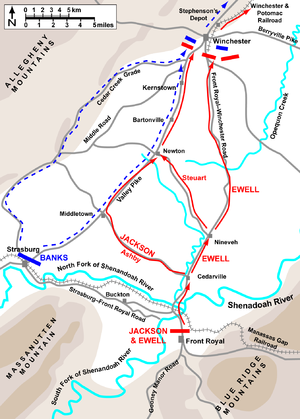
Battle of Front Royal
Encyclopedia
The Battle of Front Royal, also known as Guard Hill or Cedarville, was fought May 23, 1862, in Warren County, Virginia
Warren County, Virginia
As of the census of 2000, there were 31,584 people, 12,087 households, and 8,521 families residing in the county. The population density was 148 people per square mile . There were 13,299 housing units at an average density of 62 per square mile...
, as part of Confederate Army
Confederate States Army
The Confederate States Army was the army of the Confederate States of America while the Confederacy existed during the American Civil War. On February 8, 1861, delegates from the seven Deep South states which had already declared their secession from the United States of America adopted the...
Maj. Gen. Thomas J. "Stonewall" Jackson's Campaign through the Shenandoah Valley
Shenandoah Valley
The Shenandoah Valley is both a geographic valley and cultural region of western Virginia and West Virginia in the United States. The valley is bounded to the east by the Blue Ridge Mountains, to the west by the eastern front of the Ridge-and-Valley Appalachians , to the north by the Potomac River...
during the American Civil War
American Civil War
The American Civil War was a civil war fought in the United States of America. In response to the election of Abraham Lincoln as President of the United States, 11 southern slave states declared their secession from the United States and formed the Confederate States of America ; the other 25...
. Front Royal demonstrated Jackson's use of Valley topography and mobility to unite his own forces while dividing those of his enemies. At a minimal cost, he forced the withdrawal of a large Union army by striking at its flank and threatening its rear.
Background

Nathaniel Prentice Banks
Nathaniel Prentice Banks was an American politician and soldier, served as the 24th Governor of Massachusetts, Speaker of the U.S. House of Representatives and as a Union general during the American Civil War....
, numbering about 9,000 men, was concentrated in the vicinity of Strasburg, Virginia
Strasburg, Virginia
Strasburg is a town in Shenandoah County, Virginia, United States, which was founded in 1761 by Peter Stover. It is the largest town, population-wise, in the county and is known for its pottery, antiques, and Civil War history...
, with two companies of infantry at Buckton Depot. Col. John R. Kenly
John Reese Kenly
John Reese Kenly was an American lawyer, and a Union general in the American Civil War.-Biography:...
commanded 1,063 men and two guns at Front Royal. Confederate cavalry under Col. Turner Ashby
Turner Ashby
Turner Ashby, Jr. was a Confederate cavalry commander in the American Civil War. He had achieved prominence as Thomas J. "Stonewall" Jackson's cavalry commander, in the grade of colonel, in the Shenandoah Valley before he was killed in battle in 1862...
confronted Banks near Strasburg, but then withdrew to join the main army, which crossed Massanutten Mountain via New Market Gap to reach Luray, Virginia
Luray, Virginia
Luray is a town in Page County, Virginia, United States, in the Shenandoah Valley of the northern part of the state. It is also the county seat...
.
On May 22, Jackson's Army of the Valley
Army of the Valley
The Army of the Valley was the name given to the army of Lt. Gen. Jubal Early's independent command during the Shenandoah Valley Campaigns in the summer and autumn of 1864. The Army of the Valley was the last Confederate unit to invade Northern territory, reaching the outskirts of Washington, D.C....
(about 16,500 men) advanced along the muddy Luray Road to within ten miles of Front Royal. Jackson's headquarters were at Cedar Point. Colonel Thomas T. Munford
Thomas T. Munford
Thomas Taylor Munford was an American farmer and Confederate brigadier general during the American Civil War.-Biography:...
's cavalry regiment was sent east to close off Manassas Gap and cut communication between Front Royal and Washington, D.C.
Washington, D.C.
Washington, D.C., formally the District of Columbia and commonly referred to as Washington, "the District", or simply D.C., is the capital of the United States. On July 16, 1790, the United States Congress approved the creation of a permanent national capital as permitted by the U.S. Constitution....
Battle

Shenandoah River
The Shenandoah River is a tributary of the Potomac River, long with two forks approximately long each, in the U.S. states of Virginia and West Virginia...
at McCoy's Ford. The infantry continued to Asbury Chapel and right onto a cross road to reach Gooney Manor Road. Following this road, they approached Front Royal from the south, bypassing Federal pickets stationed near the river on the Luray Road one mile south of the courthouse. After minor skirmishing the Federals withdrew.
Jackson's leading brigade, under the leadership of Brig. Gen. Richard Taylor
Richard Taylor (general)
Richard Taylor was a Confederate general in the American Civil War. He was the son of United States President Zachary Taylor and First Lady Margaret Taylor.-Early life:...
, deployed on Prospect Hill and along the ridge to the east. The 1st Maryland Infantry, CSA
1st Maryland Infantry, CSA
The 1st Maryland Infantry, CSA was a regiment of the Confederate army, formed shortly after the commencement of the American Civil War in April 1861. The unit was made up of volunteers from Maryland who, despite their home state remaining in the Union during the war, chose instead to fight for the...
and Major Roberdeau Wheat's Louisiana "Tigers" battalion
Louisiana Tigers
Louisiana Tigers was the common nickname for certain infantry troops from the state of Louisiana in the Confederate States Army during the American Civil War. Originally applied to a specific company, the nickname expanded to a battalion, then to a brigade, and eventually to all Louisiana troops...
were thrown out in advance, entering the town and clearing it of Union skirmishers.
The battle is notable in that the 1st Maryland CSA was thrown into battle with their fellow Marylanders, the Union 1st Maryland Regiment., the only time in United States military history that two regiments of the same numerical designation and from the same state have engaged each other in battle. On the day of the battle Captain William Goldsborough of the 1st Maryland Infantry, CSA
1st Maryland Infantry, CSA
The 1st Maryland Infantry, CSA was a regiment of the Confederate army, formed shortly after the commencement of the American Civil War in April 1861. The unit was made up of volunteers from Maryland who, despite their home state remaining in the Union during the war, chose instead to fight for the...
captured his brother Charles Goldsborough of the 1st Maryland Infantry, USA, and took him prisoner.
Col. Kenly, in command of Union forces, withdrew his force to Camp (Richards') Hill, supported by a section of artillery. The Union line extended in an arc from the South Fork to Happy Creek, defending the South Fork bridge. Kenly's artillery opened fire and slowed the Confederate advance. Kenly's headquarters were in the Vanoort House.
The Confederate infantry advanced through town, deploying into line of battle under an accurate artillery fire. A Confederate flanking column moved to the east, crossing Happy Creek in an attempt to force Union withdrawal without a frontal assault. After a long delay because of the muddy roads, a battery of rifled artillery was deployed on or near Prospect Hill to counter the Union guns on Camp Hill.
In the meantime, after crossing the South Fork at McCoy's Ford, Ashby's and Lt. Col. Flournoy's 6th Virginia Cavalry
6th Virginia Cavalry
The 6th Virginia Volunteer Cavalry Regiment was a cavalry regiment raised in Virginia for service in the Confederate States Army during the American Civil War. It fought mostly with the Army of Northern Virginia....
rode via Bell's Mill and Waterlick Station to reach the Union outpost at Buckton Depot. Ashby made a mounted assault, which cost him several of his best officers before the Union defenders surrendered. Ashby cut the telegraph lines, severing communication between the main Union army at Strasburg and the detached force at Front Royal. He then divided the cavalry, sending Flournoy's regiment east toward Riverton to threaten Kenly's rear. Ashby remained at Buckton Depot astride the railroad to prevent reinforcements from being sent to Front Royal.
On discovering that Confederate cavalry was approaching from the west, Col. Kenly abandoned his position on Camp Hill, retreated across the South and North Fork bridges, and attempted to burn them. He positioned part of his command at Guard Hill, while the Confederates ran forward to douse the flames, saving the bridges. While Confederate infantry repaired the bridges for a crossing, Flournoy's cavalry arrived at Riverton and forded the river, pressing Kenly's forces closely. As soon as the Confederate infantry crossed, the Union position could be flanked by a column moving along the river. Kenly chose to continue his withdrawal, his outmatched cavalry fighting a rear guard action against Flournoy's 6th Virginia Cavalry.
Kenly withdrew along the Winchester turnpike beyond Cedarville, Virginia, with Flournoy's cavalry in close pursuit. Jackson rode ahead with the cavalry, as Confederate infantry began to cross the rivers. At the Thomas McKay House, one mile north of Cedarville, Kenly turned to make a stand, deploying on the heights on both sides of the pike. Flournoy's cavalry swept around the Union flanks, causing panic. Kenly fell wounded, and the Union defense collapsed. More than 700 Union soldiers threw down their weapons and surrendered.
Aftermath

Winchester, Virginia
Winchester is an independent city located in the northwestern portion of the Commonwealth of Virginia in the USA. The city's population was 26,203 according to the 2010 Census...
, in the rear of the Union army. On May 24, Banks retreated down the Valley Pike to Winchester, harassed by Confederate cavalry and artillery at Middletown and Newtown (Stephens City), setting the stage for the First Battle of Winchester
First Battle of Winchester
The First Battle of Winchester, fought on May 25, 1862, in and around Frederick County, Virginia, and Winchester, Virginia, was a major victory in Confederate Army Maj. Gen. Thomas J. "Stonewall" Jackson's Campaign through the Shenandoah Valley during the American Civil War. Jackson enveloped the...
the following day.
The confusion engendered by Jackson's appearance at Front Royal and the hasty Union retreat from Strasburg to Winchester contributed materially to the defeat of Banks's army at First Winchester on May 25. Jackson used his cavalry to good advantage at Front Royal, to sever Union communications east and west, and to strike the final blow at Cedarville.
After the battle, the victorious First Maryland CSA took charge of prisoners from the beaten Union First Maryland regiment. Many men recognized among them former friends and family. According to J. J. Goldsborough, who chronicled the history of the Maryland Line
Maryland Line (CSA)
The Maryland Line in the Army of the Confederate States of America was made up of volunteers from Maryland who, despite their home state remaining in the Union, fought for the Confederate States of America during the American Civil War...
in the Confederate Army:
- "nearly all recognized old friends and acquaintances, whom they greeted cordially, and divided with them the rations which had just changed hands".

